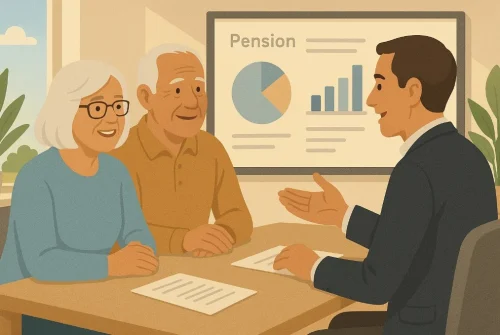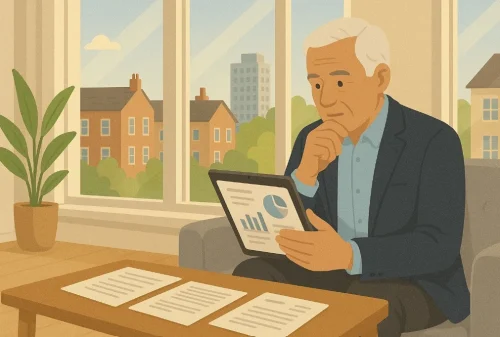Table of Contents
If you’re working while drawing a pension in the UK, understanding your tax liability is vital. Your total income, including earnings, pensions, and even rental income, determines how much tax you owe.
Navigating this can be tricky because different income sources are taxed in different ways. You may find yourself in a higher tax bracket or on the wrong tax code without even realising it.
This guide explains how tax is calculated on your pension when you’re still working and how you can plan effectively to minimise unnecessary payments while staying compliant with HMRC rules.
What Counts as Taxable Income When You’re Still Working and Claiming a Pension?

If you’re working while claiming a pension, HMRC assesses your total taxable income. This includes salary, pensions, rental earnings, and savings (excluding ISAs). Each source is taxed separately but adds up to determine your overall bill.
You’re only taxed on income above your allowances. For example, the Personal Allowance currently lets you earn £12,570 tax-free per year, with the rest taxed according to your band.
Taxable and Non-Taxable Income Overview
| Type of Income | Is It Taxable? | How It’s Taxed |
| Full-Time Employment | Yes | PAYE |
| Personal or Workplace Pension | Yes (75% usually) | Pension Provider Deducts Tax |
| State Pension | Yes | Taxed via PAYE on other income |
| Savings Interest (non-ISA) | Partially | Subject to Personal Savings Allowance |
| Rental Property Income | Yes | Declared via Self-Assessment |
| 25% of Pension Drawdown | No | Tax-Free Lump Sum |
Managing work and pension income together means keeping track of your tax bands to avoid surprises.
How Does the Personal Allowance Apply If You Have Multiple Sources of Income?
Your Personal Allowance, currently £12,570, applies to your total combined income. HMRC allocates this allowance first to the income that is taxed through PAYE.
If your earnings from one source, such as your salary, fully use up this allowance, your pension income will be taxed in full.
The order of how the allowance is used matters. If your job uses up the Personal Allowance, any additional income from pensions or property becomes fully taxable. It’s essential to monitor how your allowance is allocated.
Key Points to Remember:
- Your total income includes all taxable earnings combined.
- The allowance is applied first to the income taxed at source (usually employment).
- If your total income exceeds £100,000, your allowance is reduced gradually.
Tip:
- Speak to HMRC if you want your tax code adjusted to spread your allowance more effectively.
Keeping track of how your Personal Allowance is applied ensures you don’t pay more tax than necessary and helps you plan your income efficiently.
Do You Pay Income Tax on Your State Pension?
Yes, your State Pension is taxable. However, it’s not taxed at the source. Instead, HMRC collects tax through other taxable income you receive, such as employment or a private pension.
If the State Pension pushes your total income above the Personal Allowance, the excess becomes taxable.
Since the State Pension isn’t taxed directly, if you have no other source of income, you might not pay any tax.
But if you’re still working, expect this income to be added to your total taxable earnings. That’s why it’s important to check your combined income to avoid unexpected tax liabilities.
How Is Tax Deducted from Private or Workplace Pensions?

Private and workplace pensions are generally taxed through PAYE. Your pension provider acts similarly to an employer, deducting tax based on your tax code. If you’ve taken a lump sum or regular income, only 75% of it is considered taxable the remaining 25% is tax-free.
Errors often occur when the provider doesn’t have your correct tax code, which can lead to emergency taxation. You can claim back any overpaid tax by contacting HMRC. Staying informed about how your pension is taxed can prevent unpleasant surprises and ensure you’re not overpaying.
How Tax is Applied to Pension Withdrawals?
| Withdrawal Method | Tax Treatment |
| Take all as a lump sum | 25% tax-free, 75% taxed at applicable income rate |
| Withdraw monthly income | 25% of each withdrawal tax-free, 75% taxed |
| Buy an annuity | Option to take 25% tax-free first, then regular taxed income |
| Combination of methods | Taxation depends on how you structure withdrawals |
What Is the Role of PAYE in Pension Payments?
PAYE, or Pay As You Earn, is used by pension providers to deduct income tax before you receive your payment. This means your provider uses your tax code to estimate how much tax you owe. If your tax code is incorrect or outdated, you may end up paying too much or too little tax.
When you’re working and claiming a pension, PAYE applies to both income sources unless you’re self-employed. It’s vital to ensure HMRC has your current employment status and income details so the correct code is applied.
Can You Be Put on an Emergency Tax Code for Your Pension?
Yes, if your pension provider doesn’t have a valid tax code for you, they might apply an emergency tax code. This often results in higher tax deductions because the code assumes no other allowances or income details are known.
Emergency codes are typically temporary, and once HMRC receives accurate information, the correct tax code is applied. If you’ve been overtaxed, you can request a refund by submitting a form or contacting HMRC. Always review your pension pay slips to catch emergency taxation early.
Can Working While Receiving a Pension Push You into a Higher Tax Band?
Absolutely. The more you earn, the more tax you pay. If your employment income and pension combined exceed the thresholds for higher-rate taxation, you’ll pay more tax. This applies not only to income tax but can also impact your entitlement to savings allowances.
It’s important to calculate your total income annually and check which tax band you fall into. Many people are surprised when drawing a pension tips them into a higher band, especially if they take a large lump sum.
Example: Income Tax Bands and Tax Impact
| Total Income | Tax Band | Income Tax Rate |
| Up to £12,570 | Personal Allowance | 0% |
| £12,571 – £50,270 | Basic Rate | 20% |
| £50,271 – £125,140 | Higher Rate | 40% |
| Over £125,140 | Additional Rate | 45% |
Being aware of how your combined income affects your tax band can help you plan withdrawals and earnings to minimise unnecessary tax.
What Tax-Free Pension Options Are Still Available If You’re Working?

Even while working, you can take advantage of tax-free elements in your pension. The most significant of these is the 25% tax-free lump sum from your personal pension. This amount can be taken as a single withdrawal or across multiple payments depending on your plan.
You can also make pension contributions while working and receive tax relief on those contributions. This allows your pension to grow more efficiently.
Tax-Free Options Include:
- Taking 25% of your pension pot tax-free
- Using salary sacrifice to reduce taxable income
- Claiming tax relief on new contributions
- Deferring pension to reduce tax impact
Things to Watch:
- Ensure you stay within annual pension contribution limits
- Monitor your overall income to avoid tipping into a higher tax bracket
- Coordinate pension withdrawals with employment income
By understanding and using these tax-free pension options, you can maximise your retirement savings while keeping your current tax bill under control.
Are Defined Benefit and Defined Contribution Pensions Taxed Differently?
Yes, defined benefit (DB) and defined contribution (DC) pensions differ in how they pay out, but both are subject to income tax once you start drawing them. Defined benefit pensions offer a guaranteed income based on salary and years worked. They’re taxed through PAYE once payments begin.
Defined contribution pensions are more flexible. You choose how to draw funds, making them more complex from a tax perspective. How you withdraw impacts the taxable amount.
Tax Implications of a Defined Contribution Pension
With a DC pension, you can withdraw 25% of your pot tax-free. The remaining 75% is subject to income tax based on your total income for the year. If you’re still working, combining this with your salary could increase your tax rate.
The flexibility in drawdown methods lets you control when and how much tax you pay. Strategic withdrawals can help you stay in a lower tax band.
Defined Contribution Pension Tax Scenarios
| Withdrawal Type | Taxable? | Tax Band Impact |
| Lump Sum (25% of pot) | No | Does not impact tax band |
| Monthly Drawdown | 75% taxed | Increases total annual income |
| Annuity Income | Fully taxable | Added to employment income |
| Small Payments (flexi-access) | Partially taxed | You choose how much is tax-free/taxable |
Understanding the differences in taxation between DB and DC pensions allows you to plan withdrawals strategically and manage your overall tax efficiently.
What Steps Can You Take to Avoid Paying Too Much Tax on Pension and Work Income?

Managing your income carefully can help reduce your overall tax burden. One effective method is to spread pension withdrawals over several years rather than taking large lump sums. This can prevent crossing into a higher tax bracket.
You should also review your tax code regularly, especially when your income changes. If you notice an emergency code or incorrect tax deductions, contact HMRC. Another helpful strategy is deferring your pension if you’re still working and don’t need it yet.
Tax-Saving Strategies Include:
- Deferring pension access if not needed
- Taking smaller drawdowns to avoid higher tax brackets
- Using salary sacrifice to lower income
- Ensuring your tax code is accurate
- Claiming tax relief on pension contributions
- Keeping total income under £50,270 to remain in the basic rate band
By planning withdrawals and monitoring your income carefully, you can minimise tax liability and make the most of your pension and earnings.
Conclusion
Paying tax on your pension while working depends entirely on your total income. Your employment earnings, pension withdrawals, and other income sources are combined to determine your tax rate.
By understanding the rules around allowances, tax codes, and withdrawal options, you can make informed decisions that reduce how much tax you pay and maximise your retirement income.
Frequently Asked Questions
How is my pension taxed if I take a lump sum while working?
You can take 25% of your pension lump sum tax-free, while the remaining 75% is added to your taxable income and taxed according to your total income.
Will my employer know I’m claiming a pension?
Not necessarily. Unless your pension affects your tax code significantly, there’s no requirement for your employer to be informed automatically.
Does claiming a pension affect National Insurance contributions?
No, pensions are not subject to National Insurance, though you may still pay NI on employment income if under State Pension age.
Can I defer my pension to reduce my tax bill?
Yes, deferring your pension can delay taxable income and help you stay in a lower tax bracket if you’re still earning from employment.
What happens if I overpay tax on my pension?
You can claim a refund from HMRC by submitting an R40 form or contacting them directly once your tax code is corrected.
How do I update my tax code when I start taking a pension?
You can update your tax code by contacting HMRC or through your personal tax account online, ensuring correct deductions on your pension.
Do pension drawdowns affect Universal Credit or other benefits?
Yes, pension income is considered when assessing eligibility for means-tested benefits like Universal Credit, which may be reduced.




